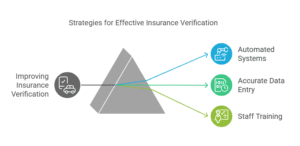Insurance verification is a critical step in Revenue Cycle Management (RCM) that directly impacts the accuracy and efficiency of billing and reimbursement processes. Accurate insurance verification ensures that healthcare providers receive proper reimbursement for services rendered, reduces claim denials, and improves cash flow. However, insurance verification can be complex, especially with multiple payers, varying policies, and frequent changes in patient coverage.
Let’s explore how healthcare providers can improve insurance verification in RCM to optimize revenue cycle processes and enhance financial stability.
Why Insurance Verification is Crucial in RCM
Insurance verification involves confirming a patient’s coverage and benefits before services are provided. This step ensures that the healthcare provider will be reimbursed for services and helps avoid unexpected financial burdens for patients. Key reasons for improving insurance verification include:
- Reducing claim denials: Verifying insurance details before service delivery ensures that claims are accurate and meet payer requirements, reducing the risk of denials.
- Ensuring correct patient responsibility: Insurance verification helps establish what the patient will owe, ensuring that providers can collect the right amount from the patient and the insurance company.
- Avoiding payment delays: Verifying insurance upfront helps streamline the claims submission process, leading to quicker payments and improved cash flow.
How to Improve Insurance Verification in RCM

1. Implement Automated Verification Tools
Automation can significantly improve the speed and accuracy of insurance verification. Automated tools can pull real-time insurance information from payer databases and streamline the verification process. Benefits include:
- Faster verification: Automated systems quickly access insurance information, reducing wait times and speeding up the process.
- Reduced errors: Automation reduces the risk of human error, ensuring that the correct insurance information is verified every time.
- Real-time updates: Automated systems provide real-time updates on changes to patient insurance coverage, keeping billing departments informed and up to date.
2. Integrate with Payer Systems
Integrating your practice management or EHR system with payer systems can streamline the insurance verification process. Key advantages include:
- Direct access to payer data: Integration allows for direct access to payer information, ensuring accurate verification of patient insurance details.
- Real-time eligibility checks: Payer integration provides real-time eligibility checks, ensuring that coverage is active and the services provided are covered under the patient’s plan.
- Improved communication: Integration ensures seamless communication between the provider and payer, reducing delays and improving the verification process.
3. Verify Insurance Information Early in the Process
Insurance verification should be conducted as early as possible to avoid delays in service delivery and payment. Key steps include:
- Verify during scheduling: During the scheduling process, request insurance details from the patient and begin the verification process.
- Pre-service verification: Perform insurance verification before the patient arrives for their appointment to ensure the services will be covered by their insurance plan.
- Verify prior to procedure or treatment: For high-cost procedures or treatments, verify insurance coverage again to ensure that any changes in the patient’s insurance status are accounted for.
4. Collect Detailed Insurance Information
To ensure accurate verification, collect all relevant insurance information from patients upfront. This information should include:
- Insurance provider details: Ensure you have the full name and contact information of the patient’s insurance provider.
- Policy numbers and group numbers: Make sure to collect the patient’s policy and group numbers to ensure that the correct coverage details are accessed.
- Plan type: Know the patient’s insurance plan type (e.g., PPO, HMO, Medicaid, Medicare) to determine the coverage limitations, co-pays, and out-of-pocket responsibilities.
5. Regularly Update Patient Information
Patient insurance details can change frequently, especially with the transition from one plan to another or with annual plan renewals. To improve verification accuracy, healthcare providers should:
- Update patient information at each visit: Verify insurance details during every patient visit to account for any changes in coverage or plan information.
- Use digital forms: Implement digital forms that allow patients to easily update their insurance information during the check-in process or via patient portals.
- Keep track of insurance updates: Ensure that patient insurance information is continuously updated in the practice management or EHR system, reducing the likelihood of errors.
6. Train Staff on Insurance Verification Processes
Properly trained staff can ensure that insurance verification is handled efficiently and accurately. Training should include:
- Understanding payer requirements: Staff should be familiar with the specific requirements of various insurance payers, including pre-authorization processes and coverage limitations.
- Effective communication with patients: Ensure that staff members can clearly explain insurance verification procedures to patients and request accurate insurance information.
- Knowledge of verification tools: Staff should be proficient in using automated verification tools, payer portals, and practice management systems to quickly verify patient coverage.
7. Improve Patient Communication
Clear communication with patients is essential for accurate insurance verification. Best practices for patient communication include:
- Clear instructions: Provide patients with clear instructions on what insurance information is required before their appointment.
- Regular reminders: Send reminders to patients to update their insurance information before visits, ensuring that you have the most up-to-date details.
- Transparency in coverage: After verification, inform patients about their coverage, out-of-pocket costs, and financial responsibilities to avoid confusion or billing disputes later.
8. Establish Strong Relationships with Payers
Building strong relationships with insurance payers can help streamline the insurance verification process and resolve any issues quickly. Key steps include:
- Frequent communication: Maintain open lines of communication with payer representatives to quickly address any questions or issues related to patient coverage.
- Payer-specific guidelines: Ensure that your practice is familiar with each payer’s specific requirements and policies to improve the accuracy of verification.
Why Insurance Verification is Key to RCM Success
Improved insurance verification is crucial for a healthy revenue cycle. When insurance information is verified accurately and promptly, healthcare providers can:
- Improve cash flow: Reduced claim denials and faster reimbursement cycles lead to better financial outcomes.
- Increase billing accuracy: Proper verification ensures that the right services are billed to the correct payer, reducing errors and discrepancies.
- Enhance patient satisfaction: Transparent communication about coverage and financial responsibilities helps build trust and reduces confusion.
Conclusion
Insurance verification is a vital part of the revenue cycle management process, and improving its accuracy can lead to faster reimbursements, fewer claim denials, and better overall financial performance. By implementing automation tools, collecting accurate information upfront, training staff, and fostering good relationships with payers, healthcare providers can streamline the verification process and enhance the efficiency of their revenue cycle. With accurate insurance verification, healthcare providers can ensure that they receive the reimbursement they are entitled to and reduce the risk of revenue loss.
What People Are Asking
1. Why is insurance verification important for RCM?
Insurance verification is important for RCM because it ensures that claims are accurate, reduces the risk of denials, and improves reimbursement rates, all of which contribute to healthy cash flow.
2. How can automation improve insurance verification?
Automation can speed up the verification process, reduce errors, and provide real-time updates on patient coverage, improving accuracy and efficiency.
3. What should healthcare providers collect during insurance verification?
Healthcare providers should collect detailed insurance provider information, policy and group numbers, plan types, and any other relevant details required for accurate verification.
4. How can patient communication improve insurance verification?
Clear instructions, regular reminders, and transparency about coverage help patients provide accurate insurance details and prevent delays or errors in the verification process.
5. How can healthcare providers handle frequent insurance changes?
By regularly updating patient information during each visit and utilizing patient portals for easy updates, healthcare providers can stay on top of changes in patient insurance coverage.
Disclaimer
For informational purposes only; not applicable to specific situations.
For tailored support and professional services,
please contact Staffingly, Inc. at (800) 489-5877
Email: support@staffingly.com.
About This Blog: This Blog is brought to you by Staffingly, Inc., a trusted name in healthcare outsourcing. The team of skilled healthcare specialists and content creators is dedicated to improving the quality and efficiency of healthcare services. The team passionate about sharing knowledge through insightful articles, blogs, and other educational resources.
 Book a Demo to Build Your Team Today!
Book a Demo to Build Your Team Today!

 Read Case Studies
Read Case Studies 


 Virtual Medical Assistants
Virtual Medical Assistants



